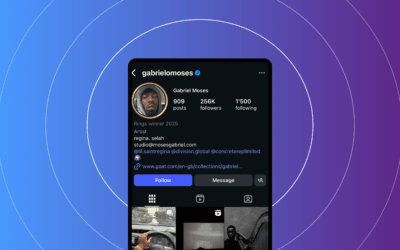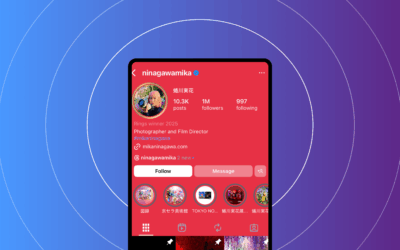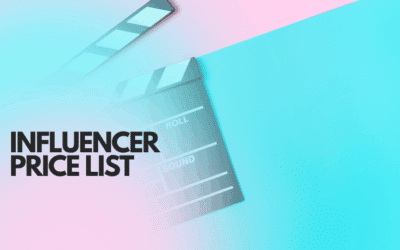What is a Micro-Influencer?
What is a Micro-Influencer? Numbers tell a remarkable story: microinfluencers on TikTok are achieving an impressive 18% engagement rate in 2024, dramatically outperforming their mega-influencer counterparts. This isn’t just a fleeting trend—it’s a fundamental shift in how audiences connect with content creators.
While mega-influencers boast millions of followers, microinfluencers are proving that smaller, more engaged communities deliver superior results. TikTok accounts with fewer than 100,000 followers maintain average engagement rates around 7.5%, compared to Instagram’s 3.65% for similar-sized accounts. The disparity becomes even more striking when examining microinfluencers specifically: Instagram microinfluencers average 6% engagement, while their TikTok counterparts nearly triple that performance.
This engagement revolution explains why 61% of brands now prioritize partnerships with nano- and micro-influencers. Marketing professionals are discovering that authentic connections and genuine audience relationships consistently outperform broad reach strategies, fundamentally reshaping influencer marketing investments and campaign effectiveness across platforms.
Defining the Microinfluencer Landscape
What Makes a Microinfluencer
Microinfluencers represent the sweet spot in social media marketing, typically boasting follower counts between 10,000 and 100,000 across platforms. For Instagram specifically, this range narrows to 5,000-50,000 followers, making them highly accessible for brands seeking authentic partnerships.
Key Characteristics of Microinfluencers
Niche Expertise: They establish themselves as authorities within specific topics, from fitness and beauty to tech and travel, building trust through specialized knowledge.
Authentic Content Creation: Their content feels genuine and relatable, often featuring personal experiences and honest product reviews that resonate with audiences.
Higher Engagement Rates: Unlike macro-influencers, microinfluencers maintain stronger connections with their communities, resulting in significantly better engagement metrics.
Influencer Tier Breakdown
- Nano-influencers: 1,000-10,000 followers
- Microinfluencers: 10,000-100,000 followers
- Mid-tier influencers: 100,000-1 million followers
- Macro-influencers: 1+ million followers
Market Position & Pricing
Microinfluencers command competitive rates of $100-$1,000 per Instagram post and $50-$800 for TikTok content, following the industry standard of $10-$20 per 1,000 followers. They constitute approximately 47.3% of all content creators, making them the largest segment in the influencer landscape.
Their combination of affordability, authenticity, and superior engagement rates makes them invaluable partners for brands seeking meaningful audience connections without the premium costs associated with celebrity influencers.
The Evolution of Influence
The influencer marketing landscape has undergone a dramatic transformation over the past decade. What began as brands simply paying celebrities with millions of followers to endorse products has evolved into something far more nuanced and effective.
Social media algorithms have fundamentally shifted the game, now prioritizing genuine engagement over vanity metrics like follower count. This algorithmic evolution has created space for micro and nano-influencers to thrive, as their smaller but highly engaged audiences deliver better results than celebrity mega-accounts.
Today’s brands recognize that authenticity trumps reach. With 61% of brands now working with nano- and micro-influencers, they’re tapping into peer-to-peer recommendations that feel organic rather than promotional. These creators have built trust within their communities, making their endorsements more credible and actionable.
The financial benefits are equally compelling. Influencer marketing CPM has dropped 53% year-over-year, while 62% of creators prefer long-term partnerships that yield higher ROI. This shift represents a maturation of the industry, where meaningful relationships between brands and creators produce better outcomes than one-off celebrity posts ever could.
The Microinfluencer Advantage
Engagement That Converts
The numbers don’t lie—microinfluencers consistently outperform their larger counterparts when it comes to authentic engagement that drives conversions. While mega-influencers boast massive reach, their engagement rates tell a different story.
Key Engagement Statistics:
- Instagram microinfluencers achieve 6% engagement vs. significantly lower rates for macro-influencers
- TikTok microinfluencers dominate with 18% engagement rates
- Mega-influencers (10M+ followers) struggle with the lowest engagement: TikTok ~2.88%, Instagram ~1.77%
- TikTok accounts under 100k followers average 7.5% engagement compared to 3.65% for similar Instagram accounts
Why This Matters for Conversions:
The inverse relationship between follower count and engagement creates a sweet spot for brands. When followers genuinely connect with content, they’re more likely to take action—whether that’s making a purchase, signing up for newsletters, or visiting websites.
Instagram leads the pack for ROI, with 64% of marketers reporting the highest returns when working with microinfluencers on the platform. This success stems from the authentic relationships these creators maintain with their audiences.
Successful campaigns often feature microinfluencers in niche markets—beauty enthusiasts promoting skincare routines, fitness creators showcasing workout gear, or food bloggers highlighting kitchen products. Their audiences trust their recommendations because they view them as peers rather than distant celebrities.
For marketers seeking meaningful engagement that translates to actual business results, the data consistently points toward microinfluencer partnerships as the most effective strategy.
Cost-Effective Marketing
Influencer marketing has become increasingly cost-effective, with CPM rates dropping 53% year-over-year. Smart marketers are leveraging this trend by strategically allocating budgets across different influencer tiers and platforms.
Platform Pricing Comparison
|
Platform |
Microinfluencers |
Macro-influencers |
|
Instagram Posts |
$100-$1,000 |
$5,000-$25,000 |
|
TikTok Posts |
$50-$800 |
$3,000-$15,000 |
|
YouTube Videos |
$200-$5,000 |
$10,000-$50,000 |
The industry standard rate averages $10-$20 per 1,000 followers per post, making microinfluencers particularly attractive for budget-conscious campaigns.
Strategic ROI Benefits
Microinfluencers, representing 47.3% of content creators, offer exceptional value with rates starting at just $100 per post. Their authentic engagement often delivers higher conversion rates than celebrity endorsements costing thousands more.
Long-term partnerships consistently yield superior ROI compared to one-off campaigns. Brands building ongoing relationships with microinfluencers see improved brand loyalty and sustained engagement at fraction of macro-influencer costs.
Budget Allocation Strategy
Marketing professionals should consider allocating 60-70% of influencer budgets to microinfluencers across multiple platforms, reserving remaining funds for selective macro-influencer partnerships during major campaigns. This diversified approach maximizes reach while maintaining cost efficiency in today’s competitive digital landscape.
Strategic Implementation
Platform Selection and Optimization
Platform Effectiveness: Instagram vs. TikTok
Instagram Performance:
- 72% of influencer campaigns utilize Instagram
- 64% of marketers report highest ROI from Instagram
- Microinfluencers achieve 6% average engagement rates
- Accounts under 100k followers see 3.65% engagement
TikTok Performance:
- 18% engagement rate for microinfluencers (3x higher than Instagram)
- 61% of marketers leverage TikTok for optimal social commerce ROI
- Accounts under 100k followers average 7.5% engagement rate
- Emerging as the preferred platform for Gen Z targeting
Platform Selection Strategy
Choose Instagram when:
- Targeting millennials and Gen X demographics
- Focusing on lifestyle, beauty, or fashion campaigns
- Requiring polished, high-quality visual content
- Seeking established influencer partnerships
Choose TikTok when:
- Targeting Gen Z audiences (ages 16-24)
- Creating viral, authentic content
- Maximizing engagement with smaller budgets
- Leveraging social commerce features
Optimization Steps
Instagram Optimization:
- Analyze competitor hashtag strategies
- Post during peak hours (11 AM – 1 PM weekdays)
- Utilize Stories and Reels for maximum reach
- Implement consistent visual branding
TikTok Optimization:
- Research trending sounds and effects
- Post 1-3 times daily during 6-10 PM
- Integrate TikTok Shop for seamless purchasing
- Focus on authentic, unpolished content
- Engage with trending challenges immediately
TikTok Shop Integration: Enable product tagging, create shoppable content, and utilize live shopping features to capitalize on TikTok’s superior social commerce conversion rates.
Finding and Vetting Microinfluencers
Discovery Methods for Microinfluencers
- Platform-Based Discovery Influencer Marketing Platforms:
- AspireIQ, Upfluence, and Creator.co for comprehensive databases
- Klear and HypeAuditor for advanced analytics
- Grin for relationship management
Manual Search Techniques:
- Use platform-specific hashtags relevant to your industry
- Explore competitor followers and engagement
- Monitor brand mentions and user-generated content
- Search location-based tags for local campaigns
- Social Listening Tools
- Brandwatch and Mention for real-time monitoring
- BuzzSumo for content performance tracking
- Hootsuite Insights for audience sentiment analysis
Comprehensive Vetting Checklist
Audience Demographics Verification
- Age, location, and gender alignment with target market
- Follower authenticity using tools like HypeAuditor
- Audience overlap analysis with existing customers
Engagement Quality Analysis
- Calculate engagement rate (likes + comments ÷ followers)
- Review comment quality for genuine interactions
- Analyze posting frequency and consistency
- Check for engagement pods or artificial inflation
Content Alignment Assessment
- Brand value compatibility review
- Content style and tone evaluation
- Previous brand partnerships analysis
- Aesthetic consistency with brand guidelines
Performance Indicators
- ROI from previous campaigns (when available)
- Audience growth trends over 3-6 months
- Cross-platform presence verification
- Professional communication assessment during initial outreach
This systematic approach ensures partnerships with authentic microinfluencers who deliver measurable results.
Building Successful Partnerships
Establishing meaningful influencer partnerships requires structured frameworks that prioritize authentic relationships over transactional exchanges. With 62% of creators preferring long-term collaborations, brands must develop sustainable partnership strategies.
Outreach Framework
Best Practices:
- Research creators whose values align with brand identity
- Personalize outreach messages with specific content references
- Lead with value proposition rather than immediate asks
- Respond promptly to maintain engagement momentum
Negotiation Considerations
Key Elements:
- Establish clear deliverable expectations upfront
- Define content approval processes and timelines
- Balance creative freedom with essential brand guidelines
- Structure compensation fairly, considering micro-influencers often accept product exchanges
Creative Freedom Balance
Successful partnerships maintain brand consistency while allowing authentic creator expression. Provide general guidelines rather than rigid scripts, enabling creators to communicate naturally with their audiences.
Long-term Relationship Management
Ambassador Program Strategies:
- Regular check-ins beyond campaign periods
- Exclusive access to new products or events
- Performance-based incentive structures
- Community building among brand ambassadors
Long-term partnerships consistently deliver higher ROI than one-off campaigns, making relationship investment essential for sustainable influencer marketing success.
Measuring Success and ROI
Key Performance Indicators
Measuring influencer marketing success requires tracking meaningful metrics beyond follower counts. Marketing professionals must focus on KPIs that demonstrate authentic engagement and business impact.
Essential KPI Tracking Framework
|
Metric Category |
Key Indicators |
Industry Benchmark |
Measurement Method |
|
Engagement |
Comments, shares, saves |
Instagram: 6%, TikTok: 18% |
Total interactions ÷ followers |
|
Reach & Awareness |
Impressions, brand mentions |
Varies by platform |
Unique accounts reached |
|
Conversions |
Click-through rate, sales |
2-5% average CTR |
Tracked links, promo codes |
|
ROI Metrics |
Cost per acquisition, ROAS |
Target: 3:1 minimum |
Revenue ÷ campaign cost |
Authentic Engagement vs. Vanity Metrics
Authentic Engagement Indicators:
- Meaningful comments with questions or personal stories
- High save-to-like ratios (indicates content value)
- Story completion rates above 70%
- Direct message responses and conversations
Vanity Metrics to Avoid:
- Raw follower count without context
- Likes without corresponding comments
- Generic emoji-only responses
Marketing teams should prioritize quality interactions that drive brand awareness and conversions. These metrics provide actionable insights for optimizing influencer partnerships and maximizing campaign ROI.
Optimization Strategies
Marketing professionals must implement systematic analysis frameworks to maximize partnership ROI. They should establish clear performance metrics including engagement rates, conversion data, and revenue attribution to evaluate campaign effectiveness.
Data-driven decision-making requires regular performance reviews where teams analyze key indicators against predetermined benchmarks. When partnerships underperform, professionals should adjust targeting parameters, content strategies, or partnership structures based on concrete insights rather than assumptions.
Successful optimization relies on continuous feedback loops. Teams must collect input from partners, monitor audience responses, and track competitive movements to identify improvement opportunities. This iterative process enables real-time strategy refinement.
Scaling proven partnerships becomes the priority once optimization frameworks are established. Marketing managers should allocate increased resources to high-performing collaborations while maintaining consistent monitoring systems. Long-term partnerships that demonstrate sustained ROI deserve expanded investment and strategic development to drive sustained business growth.
The Future of Microinfluencer Marketing
Microinfluencer marketing represents a pivotal shift in digital marketing strategy, offering brands unprecedented opportunities to connect authentically with target audiences. These content creators, comprising 47.3% of the influencer landscape, deliver remarkable engagement rates—18% on TikTok and 6% on Instagram—far exceeding traditional advertising channels.
The cost-effectiveness factor makes microinfluencer partnerships particularly attractive, with rates starting at just $100 per post. This accessibility allows brands to diversify their influencer portfolio while maintaining budget efficiency. More importantly, microinfluencers foster genuine connections with their communities, translating to higher trust levels and conversion rates.
Long-term partnerships prove most profitable, generating superior ROI compared to one-off collaborations. The authentic relationships these creators maintain with their followers create a foundation for sustained brand advocacy.
Ready to harness microinfluencer marketing’s potential? Start with pilot campaigns to test partnerships and identify high-performing creators. Scale successful collaborations gradually, focusing on building meaningful long-term relationships rather than pursuing quick wins. The future belongs to brands that prioritize authenticity over reach.
Influencer Marketing Articles
Actionable tips to get more success with influencer marketing campaigns
Who is Gabriel Moses?
Discover Gabriel Moses, the London-born artist blending fashion, music, and heritage into striking visual narratives. From Dior to Johnnie Walker, see why he’s shaping culture.
Who is Mika Ninagawa?
Discover Mika Ninagawa, Tokyo’s visionary photographer and film director celebrated for her vivid art, bold storytelling, and win at Instagram Rings 2025.
Influencer Price List: What Brands Pay in 2025 & 2026
An influencer price list is the working set of fees and terms creators (or their agents) provide — the baseline for budgeting, negotiating, and forecasting influencer campaigns.






